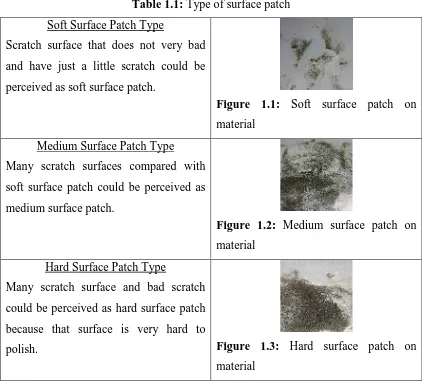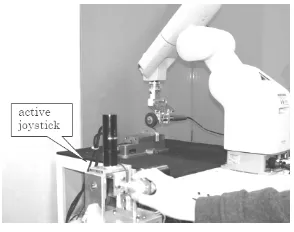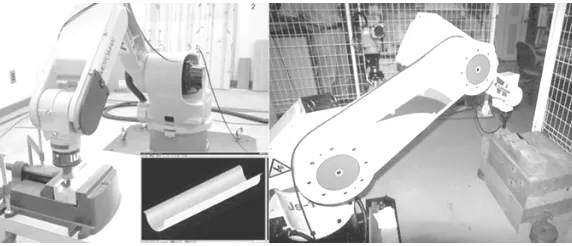I
UNIVERSITI TEKNIKAL MALAYSIA MELAKA
INVESTIGATING THE FORCE IMPOSED IN POLISHING
PROCESS FOR COMAU ROBOT
This report submitted in accordance with requirement of the Universiti Teknikal Malaysia Melaka (UTeM) for the Bachelor Degree of Manufacturing Engineering
(Robotic and Automation) with Honours.
by
MOHD FAIRUZ BIN SHAHADAN
INVESTIGATING THE FORCE IMPOSED IN POLISHING
PROCESS FOR COMAU ROBOT
MOHD FAIRUZ BIN SHAHADAN
UTeM Library (Pind.1/2007)
UNIVERSITI TEKNIKAL MALAYSIA MELAKA
BORANG PENGESAHAN STATUS TESIS*
JUDUL: ______________________________________________________________
SESI PENGAJIAN : _______________________________________________________
Saya _______________ ______________________________________________________
mengaku membenarkan t esis (PSM/ Sarj ana/ Dokt or Falsaf ah) ini disimpan di Perpust akaan Universit i Teknikal Malaysia Melaka (UTeM) dengan syarat -syarat kegunaan sepert i berikut :
1. Tesis adalah hak milik Universit i Teknikal Malaysia Melaka .
2. Perpust akaan Universit i Teknikal Malaysia Melaka dibenarkan membuat salinan unt uk t uj uan pengaj ian sahaj a.
3. Perpust akaan dibenarkan membuat salinan t esis ini sebagai bahan pert ukaran ant ara inst it usi pengaj ian t inggi.
(Mengandungi maklumat yang berdarj ah keselamat an at au kepent ingan Malaysia yang t ermakt ub di dalam AKTA RAHSIA RASMI 1972)
(Mengandungi maklumat TERHAD yang t elah dit ent ukan oleh organisasi/ badan di mana penyelidikan dij alankan)
(TANDATANGAN PENULIS)
* Tesis dimaksudkan sebagai t esis bagi Ij azah Dokt or Falsaf ah dan Sarj ana secara penyel idikan, at au disert asi bagi pengaj ian secara kerj a kursus dan penyel idikan, at au Laporan Proj ek Sarj ana Muda (PSM). ** Jika t esis ini SULIT at au TERHAD, sil a l ampirkan surat daripada pihak berkuasa/ organisasi berkenaan dengan menyat akan sekali sebab dan t empoh t esis ini perl u dikel askan sebagai SULIT at au TERHAD.
2008 / 2009
Invest igat ing t he Force Imposed In Polishing Process f or COMAU Robot
DECLARATION
I hereby, declared this report entitled “Investigating the Force Imposed in Polishing Process for COMAU Robot” is the results of my own research except as cited in
references.
Signature : ………....
Author’s Name : MOHD FAIRUZ BIN SHAHADAN
APPROVAL
This report is submitted to the Faculty of Manufacturing Engineering of UTeM as a partial fulfillment of the requirements for the degree of Bachelor of Manufacturing Engineering (Robotic and Automation) with Honors. The member of the supervisory committee is as follow:
………. MR. RUZAIDI BIN ZAMRI
Main Supervisor
i
ABSTRACT
ii
ABSTRAK
iii
DEDICATION
iv
ACKNOWLEDGEMENT
I would like to express my deep and sincere gratitude to my supervisor, Mr Ruzaidi Bin Zamri, Lecture, Department of Robotic and Automation, Faculty of Manufacturing Engineering, Universiti Teknikal Malaysia Melaka. His wide knowledge and his logical way of thinking have been of great value for me. His understanding, encouraging and personal guidance have provided a good basis for the present project.
I would like to express a special word of thanks to Mrs. Noraini Binti Husin, Lecturer, Department of Languages, Centre for Language and Human Development, Universiti Teknikal Malaysia Melaka, for her teaching of using the good language in writing this project report. Her never tirelessly to spend her time, read my project report, giving the beneficial advice and unfailing patience to me.
My warm thanks to Mr. Faizul Bin Ahmad , Technician, Robotic and Automation Laboratory, Faculty of Manufacturing Engineering, Universiti Teknikal Malaysia Melaka, for his valuable advice and friendly help. His extensive discussions around my work and interesting explorations in operations have been very helpful for this study.
v
1.1.1 Polishing process in manufacturing industry 2
1.2 Type of surface patch 4
2.3 Polishing process evolution model 11
2.3.1 Process hierarchy 11
vi
TABLE OF CONTENT
3. METHODOLOGY 19
3.1 Introduction 19
3.2 Robot application 20
3.3 Sensor application 21
3.4 Path of movement 22
3.5 Material 22
3.6 Process Flow Chart 23
3.6.1 Explanation of Process Flow Chart 24
4. RESULT AND DISCUSSION 25
4.1 Result 25
4.1.1 Experiment setup 26
4.1.2 Robot programming 27
4.1.3 Design the polishing tool 28
4.1.4 Data reading from force plate sensor 29
4.2 Discussion 32
5. CONCLUSION AND RECOMMENDATION 35
5.1 Conclusion 35
5.2 Recommendation 36
REFERENCES 37
vii
LIST OF TABLES
1.1 Type of surface patch 4
3.1 COMAU Robot Specification 20
4.1 Data collection for force plate sensor calibration process 30
viii
LIST OF FIGURES
1.1 Soft surface patch on material 4
1.2 Medium surface patch on material 4
1.3 Hard surface patch on material 4
2.1 An image of polishing task using the operating robot system 7 2.2 Polishing process on mould and furniture by robot 8
2.3 Force / Torque sensor 10
2.4 Force plate sensor 10
2.5 Polishing operation 12
2.6 Elements of operation 12
2.7 Elements of polishing model 12
2.8 Finishing evolution 13
2.9 Polishing condition 17
2.10 Graph of surface roughness according to number of polishing 18
2.11 Formula efficiency of polishing 18
3.1 COMAU NS Robot 20
3.2 Force plate sensor 21
3.3 Path Movement of Polishing Process on Material Surface 22
3.4 Work Piece Use for Polishing Process. 22
4.1 Experimental setup 26
4.2 COMAU with polishing tool 26
4.3 Polishing pad to air die grinder 28
4.4 Polishing foam and polishing pad 28
4.5 Polishing surface on material 29
4.6 Example graph of calibration process 29
4.7 Graph of calibration force plate sensor 30
ix
LIST OF FIGURES
4.10 Example graph for polishing process on hard surface patch 31
4.11 Graph of polishing force 32
x
LIST OF ABBREVIATIONS
PET - Poly Ethylene Terephthalate 3D - Three dimension view CAD - Computer Aided Design
CAM - Computer Aided Manufacturing
NC - Numerical control
DC - Direct current
N - Newton
Kg - Kilogram
RPM - Rotation per minute
1
CHAPTER 1
INTRODUCTION
This chapter will briefly discuss about the introduction to polishing process by industrial robot and the differences of surface patch. These chapters also include the problem statement, objective, and scope of the project. Besides that, this chapter will emphasize on the purpose of polishing process and it’s important to manufacturing industry.
1.1 Introduction to Polishing
Polishing is the process of creating a smooth and shiny surface by using rubbing or a chemical action, leaving a surface with significant specular reflection and minimal diffuse reflection. In this project, polishing process is done by using rubbing where the end factor of the robot will be the tool. The movement of robot is referring to difference surface patch on the material.
2
1.1.1 Polishing process in manufacturing industry
Polishing and buffing are finishing processes for smoothing a workpiece's surface using an abrasive and a work wheel. Technically polishing refers to processes that use an abrasive that is glue to work wheel, while buffing uses a loose abrasive applied to the work wheel. Polishing is a more aggressive process while buffing is less harsh, which leads to a smoother, brighter finish. A common misconception is that a polished surface has a mirror bright finish, however most mirror bright finishes are actually buffed.
Polishing is often used to enhance the looks of an item, prevent contamination of medical instruments, remove oxidation, create a reflective surface, or prevent corrosion in pipes. In metallographic and metallurgy, polishing is used to create a flat, defect-free surface for examination of a metal's microstructure under a microscope. Silicon-based polishing pads or a diamond solution can be used in the polishing process.
The removal of oxidization (tarnish) from metal objects is accomplished using a metal polish or tarnish remover. This is also called polishing. To prevent further unwanted oxidization, polished metal surfaces may be coated with a wax, oil or lacquer. This is of particular concern for copper alloy products such as brass and bronze.
3
The cut motion is designed to give a uniform, smooth, semi-bright surface finish. This is achieved by moving the workpiece against the rotation of the buffing wheel, while using medium to hard pressure. The color motion gives a clean, bright, shiny surface finish. This is achieved by moving the workpiece with the rotation of the buffing wheel, while using medium to light pressure.
When polishing brass, there are often minute marks in the metal caused by impurities. To overcome this, the surface is polished with a very fine grit, copper plated, then buffed to a mirror finish with an airflow mop. Polishing operations for items such as chisels, hammers, screwdrivers, and wrenches are given a fine finish but not plated. In order to achieve this finish four operations are required roughing, dry fining, greasing, and coloring. Note that roughing is usually done on a solid grinding wheel and for an extra fine polish the greasing operation may be broken up into two operations that is rough greasing and fine greasing. However, for inexpensive items money is saved by only performing the first two operations.
Polishing knives and cutlery is known as fine glazing or blue glazing. Sand buffing, when used on German silver, white metal, and others is technically a buffing operation because it uses a loose abrasive, but removes a significant amount of material, like polishing. Polishing may be used to enhance the looks of certain parts on cars, motorbikes, handrails, cookware, kitchenware, and architectural metal applications. Pharmaceutical, dairy, and water pipes are buffed to maintain hygienic conditions and prevent corrosion. Buffing is used to manufacture of high-quality lighting reflectors.
4
1.2 Type of surface patch
The scratch surface can be deemed and classified in three figures state. A little scratch surface could be perceived as soft surface patch type and many scratch surfaces also could be perceived as medium surface patch type. Otherwise, for too much scratch and bad scratch surface, it is could be perceived as hard surface patch type.
Table 1.1: Type of surface patch Soft Surface Patch Type
Scratch surface that does not very bad and have just a little scratch could be perceived as soft surface patch.
Figure 1.1: Soft surface patch on material
Medium Surface Patch Type
Many scratch surfaces compared with soft surface patch could be perceived as medium surface patch.
Figure 1.2: Medium surface patch on material
Hard Surface Patch Type
Many scratch surface and bad scratch could be perceived as hard surface patch because that surface is very hard to
polish. Figure 1.3: Hard surface patch on
5
1.3 Problem Statement
The scratches surface usually unequal from their aspect and also their bad of scratch. As such, a little scratch could be perceived as soft surface patch and many scratches also could be perceived as medium surface patch. For too much and bad scratch, it is could be perceived as hard surface patch. Of course, polishing process on these three types of surface require a difference force pressure. The force imposed upper that surface patch can be gauged by using force plate sensor. However, many industrial robot use force torque sensor to measure and identify force for each pressure imposed upper surface material whether in polishing, drilling, grinding and any work type that involved a force. Each difference surface patch found in surface material is unknowable how many forces should be imposed. As such, this project will investigate how many force of necessity to do polishing process of three different surface patches.
1.4 Objective
The objectives of this project are:
a) To investigate the force imposed on difference surface patch. b) To familiar with COMAU robot and force plate sensor application.
c) To test and collect the data for the force imposed during polishing process
1.5 Scope
The scopes of this project are:
a) Teaching the COMAU robot to do the polishing process for soft, medium and hard surface patch on mild steel.
6
CHAPTER 2
LITERATURE REVIEW
This chapter includes some of the polishing process by robot that will be used in manufacturing industry nowadays. This chapter also loaded with the force of polishing process and theory of sensor use. Previous researches that have been done by other researchers will be reviewed, cited and credited. The information is found in reference journal, book and electronics media such as in the internet.
2.1 Polishing process by robot
7
However, these techniques are not easily applied in industrial fields due to cost considerations. Although the advanced robot systems have been developed without consideration of cost, most of the die and mold industry consists of small businesses, and so the introduction of such expensive machines is difficult.
Figure 2.1: An image of a polishing task using the operating robot system.
The polishing robot was developed based on an open architectural industrial robot, where the kinematics and servo control are opened. In the manufacturing industry, such as of PET bottle molds and industry of wooden furniture, 3D CAD/ CAM system and NC machine tool are being used generally and widely, and these advanced systems have drastically rationalized the design and manufacturing process of the mold. However, the polishing process after NC machining has hardly automated yet. Although several polishing robots that applied a force control techniques have been proposed, but not introduced in manufacturing industry due to the poor polishing quality and complicated teaching.
8
Figure 2.2: Polishing process on mould and furniture by robot
2.2 Force of polishing process
Polishing processes is the final stage of manufacturing, and almost all such tasks depend on the dexterity of skilled workers. The resulting low efficiency of the polishing tasks decreases the productivity of the overall manufacturing process. Thus, in order to increase the overall productivity, improvement of the polishing process using robot technology is necessary.
Several robotized systems have been developed in order to automate the polishing tasks and it was developed based on an open architectural industrial robot, where the kinematics and servo control are opened. Although several polishing robots, in which force control techniques are already applied and have been proposed. But, they are not introduced in manufacturing industry because due to the poor polishing quality and complicated teaching.
9
There are several commercially accepted methods of force control used to measure the polishing force by robot today. The first method is through-the-arm force control that applies force using the position of all the robot axes in unison. The second method is around-the-arm force control. It used the robot for positioning motion only, and applies a controlled force through an auxiliary compliant end-of-arm tool. Otherwise, the tool for measured this force is like force torque sensor, that place at the end effectors of robot. But, in this project, the force will be measured by using force plate sensor that place bottom of the material to polish. This force plate sensor also can measure the force imposed on surface material that place on it during polishing process.
In many robotic tasks in the manufacturing industry, the sensor and transducers of a robot needs to come into physical contact with the work piece. Examples include part assembly, polishing, drilling, deburring, and cutting. An automated and untended work-place with flexibility and efficiency is widely envisioned as an important factory of the future. The requirements of machined components with more stringent surface finish and higher machining accuracy have led to the demand for more precise and better control of automated machining processes.


